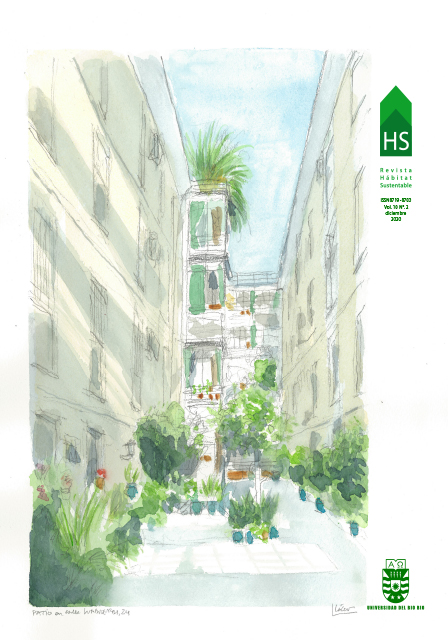Thermal performance of traditional east facing green facades in tract housing located in arid climates
DOI:
https://doi.org/10.22320/07190700.2020.10.02.06Keywords:
arid zones, bioclimatic architecture, single dwellings, Vertical Greenery SystemsAbstract
Green infrastructure is a strategy for mitigating urban and building temperatures. This work assesses the impact of a type of Vertical Greenery System (VGS), the Traditional Green Façades (TGF), on the thermal condition of dwellings located in the Metropolitan Area of Mendoza, Argentina, whose climate is dry desert (BWk - Köppen-Geiger). To this end, two case studies were monitored for two consecutive summers: a dwelling with an east-facing TGF and a control dwelling of the same typology and materiality. Outdoor and indoor ambient temperature data were recorded: surface exterior and interior, and horizontal radiation. Decreases of up to 3.1°C in the indoor ambient temperature of FVT dwellings, of up to 27.4°C on exterior walls and 6.5°C on interior walls were found. The magnitudes of the results found show the potential of applying this strategy in an arid climate.
Downloads
References
Alexandri, E. y Jones, P. (2008). Temperature decreases in an urban canyon due to green walls and green roofs in diverse climates. Building and Environment, 43(4), 480–493. DOI: https://doi.org/10.1016/j.buildenv.2006.10.055
Bustami, R. A., Belusko, M., Ward, J. y Beecham, S. (2018). Vertical greenery systems : A systematic review of research trends. Building and Environment, 146(August), 226–237. Recuperado de https://doi.org/10.1016/j.buildenv.2018.09.045
Coma, J., Pérez, G., De Gracia, A., Burés, S., Urrestarazu, M. y Cabeza, L. F. (2017). Vertical greenery systems for energy savings in buildings: A comparative study between green walls and green facades. Building and Environment, 111, 228–237. DOI: https://doi.org/10.1016/j.buildenv.2016.11.014
Contesse, M., Van Vliet, B. J. M. y Lenhart, J. (2018). Is urban agriculture urban green space? A comparison of policy arrangements for urban green space and urban agriculture in Santiago de Chile. Land Use Policy, 71(October), 566–577. DOI: https://doi.org/10.1016/j.landusepol.2017.11.006
Elsadek, M., Liu, B. y Lian, Z. (2019). Urban Forestry & Urban Greening Green façades : Their contribution to stress recovery and well-being in high- density cities. Urban Forestry & Urban Greening, 46(September). DOI: https://doi.org/10.1016/j.ufug.2019.126446
Gill, S. E., Handley, J. F., Ennos, A. R. y Pauleit, S. (2007). Adapting cities for climate change: The role of the green infrastructure. Built Environment, 33(1), 115–133. DOI: https://doi.org/10.2148/benv.33.1.115
Haggag, M., Hassan, A. y Elmasry, S. (2014). Experimental study on reduced heat gain through green façades in a high heat load climate. Energy and Buildings, 82, 668–674. DOI: https://doi.org/10.1016/j.enbuild.2014.07.087
Hoelscher, M. T., Nehls, T., Jänicke, B. y Wessolek, G. (2016). Quantifying cooling effects of facade greening: Shading, transpiration and insulation. Energy and Buildings, 114, 283–290. Recuperado de https://doi.org/10.1016/j.enbuild.2015.06.047
Kontoleon, K. J. y Eumorfopoulou, E. A. (2010). The effect of the orientation and proportion of a plant-covered wall layer on the thermal performance of a building zone. Building and Environment, 45(5), 1287–1303. DOI: https://doi.org/10.1016/j.buildenv.2009.11.013
Marchi, M., Pulselli, R. M., Marchettini, N., Pulselli, F. M. y Bastianoni, S. (2015). Carbon dioxide sequestration model of a vertical greenery system. Ecological Modelling, 306, 46–56. DOI: https://doi.org/10.1016/j.ecolmodel.2014.08.013
OCED / IEA. (2017). Energy Technology Perspectives 2017. International Energy Agency (IEA) Publications. Recuperado de https://webstore.iea.org/download/summary/237?fileName=English-ETP-2017-ES.pdf
Othman, A. R. y Sahidin, N. (2016). Vertical Greening Façade as Passive Approach in Sustainable Design. Procedia - Social and Behavioral Sciences, 222, 845–854. DOI: https://doi.org/10.1016/j.sbspro.2016.05.185
Pérez, G., Coma, J., Sol, S. y Cabeza, L. F. (2017). Green facade for energy savings in buildings: The influence of leaf area index and facade orientation on the shadow effect. Applied Energy, 187, 424–437. DOI: https://doi.org/10.1016/j.apenergy.2016.11.055
Perini, K., Ottelé, M., Fraaij, A. L. A., Haas, E. M. y Raiteri, R. (2011). Vertical greening systems and the effect on air flow and temperature on the building envelope. Building and Environment, 46(11), 2287–2294. DOI: https://doi.org/10.1016/j.buildenv.2011.05.009
Salas-Esparza, M. G. y Herrera-Sosa, L. C. (2017). La vegetación como sistema de control para las Islas de Calor Urbano en Ciudad Juárez, Chihuahua. Hábitat Sustentable, 7(1), 14-23. Recuperado de http://revistas.ubiobio.cl/index.php/RHS/article/view/2737
Suklje, T., Saso, M. y Arkar, C. (2016). On detailed thermal response modeling of vertical greenery systems as cooling measure for buildings and cities in summer conditions. Energy, 115, 1055–1068. DOI: https://doi.org/10.1016/j.energy.2016.08.095
Susorova, I., Angulo, M., Bahrami, P. y Stephens, B. (2013). A model of vegetated exterior facades for evaluation of wall thermal performance. Building and Environment, 67, 1–13. DOI: https://doi.org/10.1016/j.buildenv.2013.04.027
Vox, G., Blanco, I. y Schettini, E. (2018). Green façades to control wall surface temperature in buildings. Building and Environment, 129(September 2017), 154–166. DOI: https://doi.org/10.1016/j.buildenv.2017.12.002
Wong, I. y Baldwin, A. N. (2016). Investigating the potential of applying vertical green walls to high-rise residential buildings for energy-saving in sub-tropical region. Building and Environment, 97, 34–39. DOI: https://doi.org/10.1016/j.buildenv.2015.11.028
Wong, N. H., Kwang Tan, A. Y., Tan, P. Y., Chiang, K. y Wong, N. C. (2010). Acoustics evaluation of vertical greenery systems for building walls. Building and Environment, 45(2), 411–420. DOI: https://doi.org/10.1016/j.buildenv.2009.06.017
Downloads
Published
How to Cite
Issue
Section
License
Copyright (c) 2020 Pablo Abel Suarez, María Alicia Cantón, Érica Correa

This work is licensed under a Creative Commons Attribution-ShareAlike 4.0 International License.
The content of articles which are published in each edition of Habitat Sustentable, is the exclusive responsibility of the author(s) and does not necessarily represent the thinking or compromise the opinion of University of the Bio-Bio.
The author(s) conserve their copyright and guarantee to the journal, the right of first publication of their work. This will simultaneously be subject to the Creative Commons Recognition License CC BY-SA, which allows others to share-copy, transform or create new materials from this work for non-commercial purposes, as long as they recognize authorship and the first publication in this journal, and its new creations are under a license with the same terms.











 Scientific Information Program/Concurso Fondos de Publicación de Revistas Científicas 2018/ Proyecto Mejoramiento de Visibilidad de Revistas UBB (Código:FP180007).
Scientific Information Program/Concurso Fondos de Publicación de Revistas Científicas 2018/ Proyecto Mejoramiento de Visibilidad de Revistas UBB (Código:FP180007).





